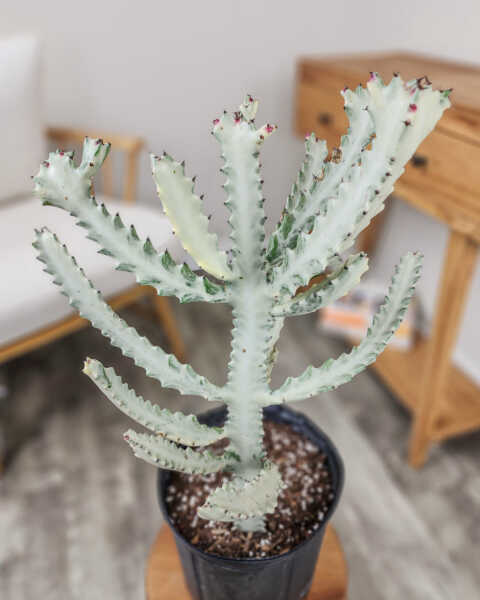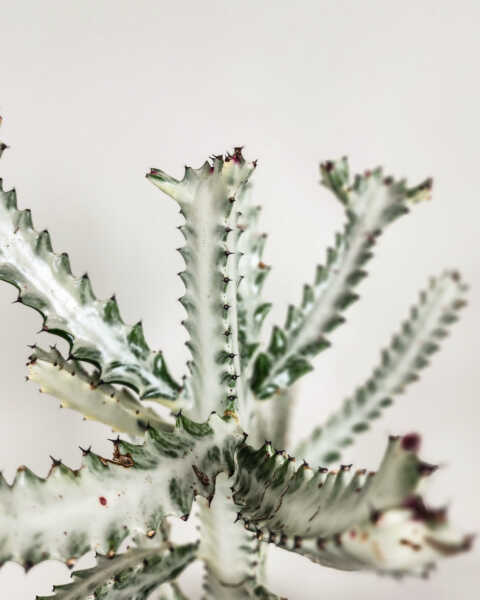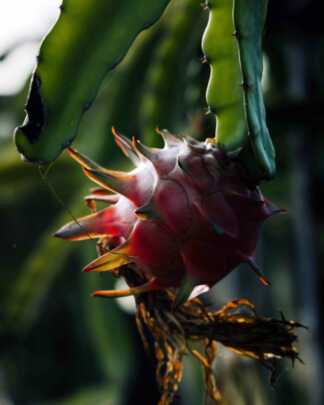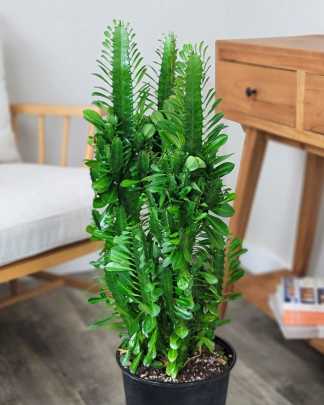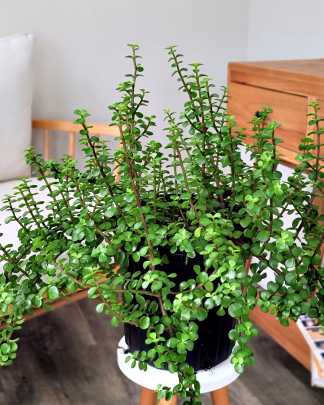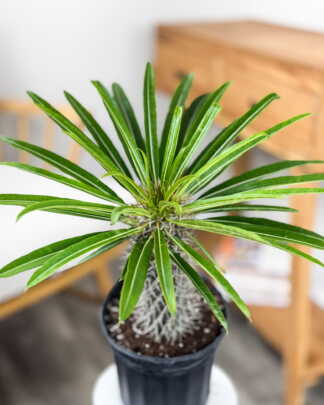Description
The Hauntingly Beautiful Cactus
The White Ghost Cactus, scientifically known as Gymnocalycium mihanovichii ‘Hibotan’, is a captivating and distinctive succulent that enchants with its otherworldly appearance. Originating from South America, particularly Argentina and Paraguay, this unique cactus variety has gained popularity among plant enthusiasts for its striking white or pale yellow coloration and intriguing growth habits. In this comprehensive care guide, we’ll explore everything you need to know to ensure the health and vitality of your White Ghost Cactus.
The White Ghost Cactus is characterized by its spherical or slightly elongated shape, often reaching a diameter of 4 to 6 inches (10 to 15 centimeters) at maturity. Its distinctive feature is its lack of chlorophyll, resulting in a pale, almost translucent appearance. This cactus typically has numerous ribs adorned with small, spineless tubercles, giving it a smooth texture. The lack of chlorophyll gives the cactus its unique white or pale yellow coloration, making it stand out among other succulents. Additionally, the White Ghost Cactus may produce delicate pink or yellow flowers in the spring or summer, adding a touch of beauty to its ghostly appearance.
Caring for your White Ghost Cactus
With its ethereal beauty and easy-care requirements, the White Ghost Cactus is a captivating addition to any indoor succulent collection. By providing the right growing conditions, including adequate light, proper watering, well-draining soil, and occasional feeding, you can enjoy the ghostly presence of this stunning cactus for years to come. Whether displayed as a solitary specimen or grouped with other succulents, the White Ghost Cactus is sure to intrigue and delight with its otherworldly charm.
Light
Providing the appropriate amount of light is crucial for the health of your White Ghost Cactus. These cacti thrive in bright, indirect light or partial shade. Place them near a south or west-facing window where they can receive ample sunlight without being exposed to direct afternoon sun, which can scorch their delicate tissues. Inadequate light can lead to etiolation, causing the cactus to become elongated and lose its compact shape, while excessive sunlight can result in sunburn and tissue damage.
Temperature
White Ghost Cacti prefer warm temperatures similar to their native habitat. Keep them in an environment where temperatures range between 65°F to 85°F (18°C to 29°C) during the day and above 50°F (10°C) at night. Avoid exposing them to sudden temperature fluctuations or drafts, as these can stress the plant and affect its overall health.
Water
Proper watering is essential for the White Ghost Cactus, as overwatering is one of the most common causes of its decline. Allow the top inch (2.5 centimeters) of the soil to dry out completely between waterings, and then water the plant thoroughly until excess water drains from the bottom of the pot. During the growing season in spring and summer, water more frequently, approximately once every two weeks, while reducing the frequency to once a month during the dormant period in fall and winter.
It’s crucial to use well-draining soil and pots with drainage holes to prevent waterlogged conditions, which can lead to root rot and other fungal diseases. Additionally, avoid getting water on the cactus’s body, as this can cause rot or discoloration.
In terms of humidity, these cacti can tolerate average indoor humidity levels. However, they benefit from slightly higher humidity levels, especially during the winter months when indoor heating can cause the air to become dry. To increase humidity, consider using a humidifier or placing a tray filled with water and pebbles beneath the plant’s container, ensuring that the bottom of the pot does not come into direct contact with the water.
Soil
White Ghost Cacti thrive in well-draining soil that replicates their natural habitat. A mix specifically formulated for cacti and succulents works well, or you can create your own by combining equal parts of potting soil, coarse sand, and perlite or pumice. This blend ensures adequate drainage while providing the necessary nutrients for healthy growth.
When repotting your White Ghost Cactus, choose a container that is slightly larger than its current one and has drainage holes at the bottom. Repotting is typically necessary every two to three years or when the plant has outgrown its current pot. Handle the cactus with care, using gloves or a folded newspaper to protect your hands from the spines.
Fertilizing
White Ghost Cacti have low fertilizer requirements and can thrive with minimal feeding. During the growing season in spring and summer, you can fertilize your cactus with a balanced liquid fertilizer diluted to half strength. Apply the fertilizer once a month, following the manufacturer’s recommendations. Avoid fertilizing during the dormant period in fall and winter, as the plant’s growth slows down during this time.
Pests and Diseases
While White Ghost Cacti are relatively resistant to pests and diseases, they may still encounter occasional problems if their growing conditions are not ideal. Common pests that may affect these cacti include mealybugs, scale insects, and spider mites. Inspect your plant regularly for signs of pest infestation, such as webbing, sticky residues, or visible insects. If pests are present, treat the affected areas with insecticidal soap or neem oil, following the product instructions carefully.
In terms of diseases, overwatering is the primary cause of fungal infections and root rot in White Ghost Cacti. To prevent these issues, ensure proper watering practices and provide adequate airflow around the plant to promote drying of the soil surface. If you notice signs of rot, such as mushy or discolored stems, immediately remove the affected areas with a sterile knife and allow the remaining tissue to callus before repotting the plant in fresh soil.
Propagation
Propagating White Ghost Cacti is relatively straightforward and can be done through several methods, including seed propagation, offsets, and grafting. Offsets, also known as pups, are small, baby cacti that develop around the base of the parent plant. Carefully separate the offsets from the parent plant using a sharp, sterile knife, ensuring that each pup has its own roots attached. Allow the cut ends to callus for a few days before planting them in well-draining soil.
Alternatively, you can propagate White Ghost Cacti from seeds collected from mature fruit or purchased from reputable suppliers. Sow the seeds in a well-draining cactus mix, lightly cover them with soil, and keep the soil consistently moist until germination occurs, which typically takes several weeks. Once the seedlings have developed several sets of true leaves, they can be transplanted into individual pots and treated as mature plants.
Grafting is another propagation method commonly used for White Ghost Cacti, particularly for varieties with unique coloration or growth habits. By grafting a segment of the White Ghost Cactus onto a hardy rootstock, you can create a more resilient plant that retains the desirable traits of the original variety.

